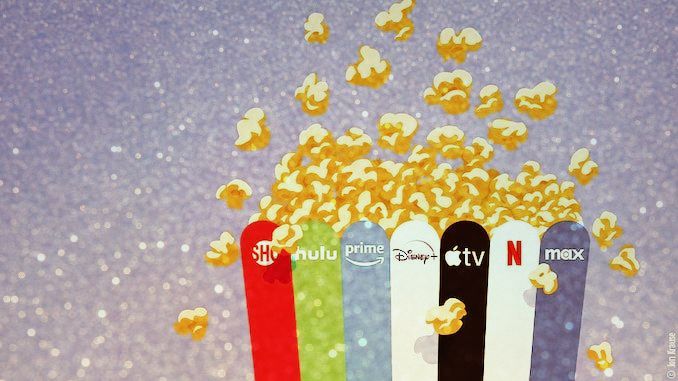
- Shifts in Content Licensing: A24 Moves To Warner Bros.
- Active Content Licensing Deals in the U.S. (Updated)
- Universal Splits Pay-1 Rights Between Streamers
- Worldwide Film & Television Distribution Intelligence
- Sony Splits Rights Between Netflix and Disney
- Starz Settles for Pay-1 Rights from Lionsgate
- FilmTake Away: Licensing Adaptations in Streaming
Distributors are realigning the traditional Pay-1 window with new strategies to maximize their reach and impact. As streaming platforms like Netflix, Prime Video, and Disney+ continue to dominate viewers’ screens, the reliance on a mix of in-house productions and external content has become crucial for sustaining subscriber interest.
However, this strategic realignment on diverse content sources has challenges. The complexities of managing licensing agreements and coordinating release schedules can create significant gaps in streaming libraries.
Content licensing has become increasingly complex, with streaming giants like Max, Paramount+, and Disney+ maneuvering to secure lucrative deals with independent production studios.
Shifts in Content Licensing: A24 Moves To Warner Bros.
The latest major industry output deal is between A24 and Warner Bros. Discovery (WBD), structured as a Pay-1 output deal. After finishing their theatrical run, all A24 films will be available exclusively on platforms owned by WBD, including HBO, Max, and Cinemax, for a predetermined period. Altogether, the agreement will deliver over 100 films to WBD throughout the term, which is thought to be three years.
A24 previously had a comparable Pay-1 deal with Showtime, signed in 2019, but it has since lapsed. Likewise, in 2018, Apple TV+ partnered with A24 on a multiyear agreement to produce a slate of original films for the tech giant. Both of these failed to raise A24’s profile.
The financial terms of the A24 and WBD deal remain undisclosed, but its significance for both parties is undeniable. For A24, aligning with HBO and Max provides access to a larger audience and potentially higher revenues, while for WBD enhancing the prestige and appeal of its streaming platform.
Active Content Licensing Deals in the U.S. (Updated)
| Film Studio | Film Slate | Pay-1 Window | Pay-2 Window, etc. |
|---|---|---|---|
| Disney | Disney | Disney+ | N/A |
| Disney | Fox / Searchlight | Disney+, Hulu, HBO, Max | N/A |
| A24 | A24 | HBO / Max / Cinemax | N/A |
| Neon | Neon | Hulu | N/A |
| Lionsgate | Lionsgate Films | Starz | N/A |
| Lionsgate | Summit | Starz | N/A |
| MGM | MGM | MGM+ | Amazon / Paramount+ |
| Paramount | Paramount | Paramount+ | MGM+ |
| Sony | Sony Pictures | Netflix | All Disney Platforms |
| Universal | Animated Films | Peacock / Netflix | Netflix |
| Universal | Live-Action Films | Peacock / Amazon | Starz |
| Warner Bros. | Warner Bros. | HBO / Max | N/A |
Universal Splits Pay-1 Rights Between Streamers
Starting this year, Pay-1 rights for Universal’s films remain in-house for streaming on the company’s direct-to-consumer streaming service Peacock. The Pay-1 window for each Universal title starts 120 days after the theatrical release and extends for four months—however, some films can reach Peacock only a few weeks after release.
Interestingly, Universal carved out a ten-month licensing period during the Pay-1 window, during which Amazon Prime Video will hold exclusive rights to stream Universal’s live-action films. HBO previously held the Pay-1 rights to Universal’s films. After this 10-month term, which lasts between months 5 and 14, Universal’s films will return to Peacock for the remaining four months of the Pay-1 window.
Similarly, Netflix splits Pay-One rights between Peacock and Netflix to Universal’s animated films. Animated films from DreamWorks Animation and Illumination are exclusive on Peacock for the first four months of the Pay-1 period before heading to Netflix for the middle ten months and then back exclusively on Peacock for the last four months.
Currently, Netflix has the second largest film catalog in the United States, behind only Max, with its access to releases by Warner Bros. Films account for 40% of Netflix’s demand in contrast to Max, where films account for 60% of demand among its users.
Content valuation has never been more critical, with streaming platforms investing billions in original programming and licensing agreements to stay competitive in a crowded market.
Get Instant Access to How Much Streamers Like Netflix, Max, Hulu, Amazon, and Paramount+ Pay to License Films and Shows Worldwide.
Worldwide Film & Television Distribution Intelligence
Get unparalleled access to market intelligence reports that draw on financial data and insights from dozens of content distribution deals worldwide between key industry participants.

Film and Series distribution rates and terms deriving from dozens of agreements for rights to transmit films and episodic television via PayTV and SVOD.
Choose flexible options for single-user PDF downloads.
Licensing Terms & Included Programs:
Pay-1 & SVOD Rate Cards for Motion Pictures and Series Exhibited Worldwide in Multiple Availability Windows
- Motion Pictures: Pay-1, First Run, Second Window Features, Recent Library Features (Tiers AAA,A,B,C), Library Features (Tiers AAA,A,B,C), Current and Premium Made-For-TV Films and Direct-To-Video Films, covering many license periods over the last decade
- Episodic TV: Current, Premium, Premium Catalog (1HR & 1/2HR), Catalog Series (1HR & 1/2HR), and Catalog Miniseries + Case Studies on Current Mega Hit, Catalog Mega Hit, and Premium Catalog, covering many licensing terms from 2012-2024
- Because most-favored-nation rates operate in practice, the rates and terms apply to a diverse range of content and distributors worldwide in multiple availability windows.
Sony Splits Rights Between Netflix and Disney
Netflix emerged as the winner in a nearly two-year auction process for the exclusive U.S. rights to stream Sony’s theatrical releases in the lucrative Pay-1 window. The window started with the studio’s 2022 slate and will last through 2026. All films from the various Sony distributor banners stream exclusively on Netflix in the U.S. after theatrical and home entertainment windows.
Disney will have the flexibility to distribute Sony’s Pictures on its streaming services Disney+ and Hulu and its linear TV networks, including ABC, Disney Channels, Freeform, FX, and National Geographic.
Unlike most Pay-1 output agreements, which traditionally have an availability window of 15-18 months for each film, Netflix will only have exclusive streaming rights for nine months before Sony’s slate is available to Disney.
Crucially, both agreements only provide Netflix and Disney rights to Sony’s films on their respective U.S. services. Sony will hold onto international streaming rights for a more traditional piecemeal licensing approach.
Starz Settles for Pay-1 Rights from Lionsgate
After losing its long-standing Pay-1 rights to feature films released by Sony Pictures, Starz went in-house by licensing films released by Lionsgate and Summit, which started at the end of 2021 and 2022, respectively.
In place of Pay-1 rights to studio films, Starz secured a Pay-2 window to Universal’s film slate that started this year. The deal gives Starz access to live-action films from Universal Pictures, Focus Features, and Blumhouse after an 18-month Pay-1 period. Starz also maintains library deals for older films with Disney (set to expire in 2025), Warner Bros., Universal, MGM, and Paramount.
It’s hard to imagine Starz growing its subscriber base in a contracting market without major studio theatrical hits to promote. Its recent bundling partnership with MGM+ could help offset these losses.
FilmTake Away: Licensing Adaptations in Streaming
Recent deals for the Pay-1 window are emblematic of the broader shifts in the streaming industry. Content valuations have skyrocketed, prompting platforms to invest heavily in original programming and complex licensing deals to stay competitive in an increasingly crowded market.
While studios realize the need for original content to grow their respective direct-to-consumer streaming services, they also realize the need for outside licensing revenue from competing studios and streaming services.